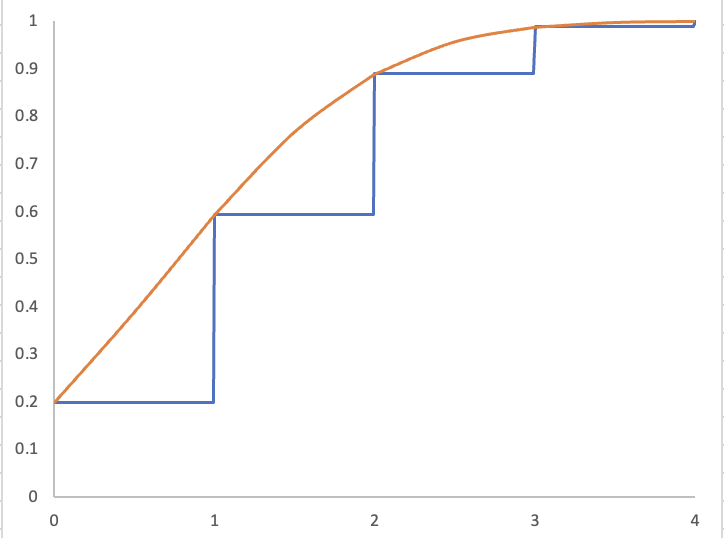I am brand new to the site.
Here is Henry's plot using Ian's formula. CDF of Binomial(k,n,p) = 1 - CDF of Beta(p, k+1, n-k).
In Excel, I did BINOM.DIST(i,4,0.333,TRUE) for i = 0 to 4. Then, I did 1-BETA.DIST(0.333,1+i,4-i,TRUE) for i = 0 to 3.99.
This is because the jth order statistic $X_{(j)}$ of n i.i.d. Unif(0,1) r.v.s is distributed with pdf Beta(j, n-j+1). So, the cdf is the cumulative Beta distribution.
$P(X_{(j)} \le x) = \int_{0}^{x}Beta(\theta, j, n-j+1)d\theta$
In general, the cdf of the order statistic is given by
$P(X_{(j)} \le x) = \sum_{k=j}^{n} {n\choose k} F(x)^k(1-F(x))^{n-k}$
If X ~ Unif(0,1), then $F(x) = x$, so
$P(X_{(j)} \le x) = \sum_{k=j}^{n} {n\choose k} x^k(1-x)^{n-k}$
Change to sum from k = 0 to j-1 and subtract from 1.
$P(X_{(j)} \le x) = 1 -\sum_{k=0}^{j-1} {n\choose k} x^k(1-x)^{n-k}$
Let $i = j-1$,
$P(X_{(i+1)} \le x) = 1 -\sum_{k=0}^{i} {n\choose k} x^k(1-x)^{n-k}$
substitue $i + 1$ for $j$ in the Beta cdf integral above.
$P(X_{(i+1)} \le x)= \int_{0}^{x}Beta(\theta, i+1, n-i)d\theta$
Set the two right-hand sides equal, and we have
$ 1 - \sum_{k=0}^{i} {n\choose k} x^k(1-x)^{n-k}) = \int_{0}^{x}Beta(\theta, i+1, n-i)d\theta$
or
cdf of Binomial(i, n, x) = 1- cdf of Beta(x, i+1, n-i).
This is what I said above with x replacing p and i replacing k.

